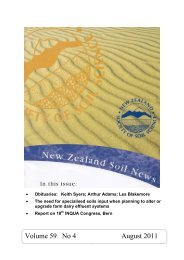Volume 55 No 2 April 2007 - New Zealand Society of Soil Science
Volume 55 No 2 April 2007 - New Zealand Society of Soil Science
Volume 55 No 2 April 2007 - New Zealand Society of Soil Science
Create successful ePaper yourself
Turn your PDF publications into a flip-book with our unique Google optimized e-Paper software.
The contribution <strong>of</strong> the Universities<br />
Canterbury Agricultural College (later renamed Lincoln College and subsequently reconstituted as<br />
Lincoln University) was the first university institution to teach soil science. Prior to the appointment <strong>of</strong><br />
Dr Burns as senior lecturer in 1937 the emphasis had been on soil chemistry and the analysis and<br />
application <strong>of</strong> fertilizers. Wild had begun a soil survey <strong>of</strong> part <strong>of</strong> the Wairau Plains when a teacher at<br />
Marlborough High School between 1911 and 1913. Whilst at Lincoln between 1915 and 1925, he<br />
published <strong>Soil</strong>s and Manures in <strong>New</strong> <strong>Zealand</strong>. The 19<strong>55</strong> edition <strong>of</strong> this book included an updated<br />
section on soils <strong>of</strong> <strong>New</strong> <strong>Zealand</strong> based on information provided by Taylor and Pohlen. Dr Burns had<br />
gained a comprehensive knowledge <strong>of</strong> soils, soil fertility and aspects <strong>of</strong> soil conservation from his<br />
postgraduate studies at Aberdeen and Cornell Universities. His focus was in teaching basic soil<br />
husbandry skills to diplomate and graduate students in agriculture, establishing short courses for<br />
returned service-men, and in 1946 initiating the first lecture course in soil conservation and soil<br />
erosion at the college, to compliment McCaskill’s lectures on the history and practice <strong>of</strong> soil<br />
conservation. Dr Burns resigned in 1949. McCaskill continued to <strong>of</strong>fer courses in soil conservation,<br />
until he became Director <strong>of</strong> the Tussock Grasslands and Mountainlands Institute in the early 1960s.<br />
Brian Douglas, formerly a forester and soil conservator, was appointed in 1962 to lecture in soil<br />
conservation. He was initially based in the <strong>Soil</strong> <strong>Science</strong> Department but subsequently transferred to<br />
the Agricultural Engineering Department. By this time soil conservation was taught as part <strong>of</strong> a subject<br />
entitled watershed management. Over the following decades Dr Tim Davies added courses in land and<br />
water science and management. Dr Davies moved to the University <strong>of</strong> Canterbury in 2003 and by<br />
2005 the emphasis had changed from soil conservation to sustainable rural land-use.<br />
Pedology and soil survey were not emphasized in teaching until Dr Thomas W. Walker was appointed<br />
foundation Pr<strong>of</strong>essor <strong>of</strong> <strong>Soil</strong> <strong>Science</strong> in 1952. Pedology had been enlivened in the post war years<br />
following the publication <strong>of</strong> Hans Jenny’s Factors <strong>of</strong> <strong>Soil</strong> Formation. Pr<strong>of</strong>essor Walker, Arthur F.R.<br />
Adams and Hector D. Orchiston, established a series <strong>of</strong> fertilizer trials on Canterbury soil sequences<br />
identified by Raeside and Cutler. They applied Jenny’s concepts to the study <strong>of</strong> nutritional factors<br />
influencing biological nitrogen fixation. In particular the influence <strong>of</strong> sulphur, phosphorus, and<br />
molybdenum deficiencies in clover and grass pastures. These studies set a foundation for future<br />
studies <strong>of</strong> soil nutrient limitations in soil sequences and their amendment by the use <strong>of</strong> fertilizers. In<br />
1958 Walker resigned to become Pr<strong>of</strong>essor <strong>of</strong> Agriculture at the University <strong>of</strong> <strong>New</strong>castle on Tyne<br />
where he was influenced by a noted English pedologist Edward Crompton. Pr<strong>of</strong>essor Walker was<br />
reappointment to Canterbury Agricultural College in 1960. In the following two decades there were<br />
further soil sequence studies, based on chronosequences, climosequences and lithosequences in both<br />
South and <strong>No</strong>rth Islands, the first and most notable being the study <strong>of</strong> the Franz Josef chronosequence.<br />
In the 1960s Bernard L. Elphick, previously a research <strong>of</strong>ficer studying the chemistry <strong>of</strong> lime and its<br />
reaction in soils, began teaching pedology, but he had little or no field experience to call upon and<br />
enliven the subject. Pedology and instruction in soil survey took a leap forward when Cutler brought<br />
his twenty three years <strong>of</strong> soil survey experience to the <strong>Soil</strong> <strong>Science</strong> Department in 1967, followed by<br />
Philip J. Tonkin in 1969 also recruited from DSIR <strong>Soil</strong> Bureau and Andrew W. Young in 1974, a<br />
Lincoln graduate. By the 1970s the teaching programme was expanded with the advanced course in<br />
pedology and soil survey supported by courses in earth science and geomorphology. In latter years the<br />
emphasis changed to suit the development <strong>of</strong> additional degree programmes in resource studies and<br />
landscape architecture, complementing existing degrees in agriculture and horticulture. <strong>Soil</strong> science<br />
including a component <strong>of</strong> soil survey was taught principally to forestry students at Canterbury<br />
University by Lincoln University staff. Throughout the 1960s to 1980s a number <strong>of</strong> postgraduates<br />
were employed as soil conservators and pedologists with some completing Ph.D. degrees in <strong>New</strong><br />
<strong>Zealand</strong> and overseas universities. Cutler retired in 1984 to be replaced by Dr Robert Kemp who in<br />
turn resigned in 1990 and was replaced by Peter C. Almond, a Massey graduate with soil survey<br />
experience with DSIR <strong>Soil</strong> Bureau and the <strong>New</strong> <strong>Zealand</strong> Forest Service. Dr Tonkin retired in 2002 and<br />
was replaced by Dr Carol Smith, a graduate <strong>of</strong> Reading and Aberdeen Universities (UK) in 2004. Drs<br />
Tonkin, Kemp, Almond and Smith all had postgraduate training in pedology and soil survey.<br />
Massey Agricultural College (later reconstituted as Massey University) appointed Abram W. Hudson<br />
the first Pr<strong>of</strong>essor <strong>of</strong> <strong>Soil</strong>s and Field Husbandry in 1951, after first arriving as a lecturer in soils and<br />
fertilisers in 1935. Pr<strong>of</strong>essor Hudson conducted numerous long-term fertiliser and lime field trials<br />
around the <strong>No</strong>rth Island, and was responsible for the establishment <strong>of</strong> the Drainage Extension Service.<br />
69










